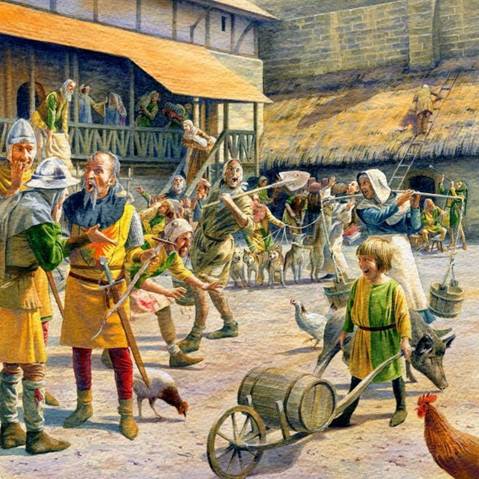
Salty Sam’s Fun Blog for Children
Number 409
The History of Roads
Hello Everyone

Even though it was chilly winter weather this week, Emily, Bill and Bob and l went for a walk behind Auntie Alice’s cottage.
We went through the woods to the fields beyond and then we came back along the river.
There are paths to walk along through the woods. There are many of them and you can choose which ones to follow.
We know the woods so well by now that we know which paths to take to get to where we want to go.
These paths were not created by people. They run between the trees and are created by animals constantly using them to travel through the woods.
They are used by rabbits, deer, foxes and badgers – even little squirrels sometimes.
The more the paths are used, the more the grass is beaten down. The more the grass is beaten down, the easier it is to use the path. The more the grass is worn down, the harder it is for grass to grow along the path.
At the dawn of human existence, people would have walked along paths like this. They were looking out for berries to pick and maybe fresh animal tracks that would tell them that there might be hunting opportunities nearby – or even an animal that might have been a danger to them.
ln Saxon times and mediaeval times, tracks like these would have been widened by carts carrying people and goods.
ln Britain, there were many tracks across the countryside that were used by drovers and carts.
Drovers were people who drove animals from their farms to market or maybe just from one pasture to another.
The animals could be moved from the valleys to the hills in spring for their summer grazing, and back again in the autumn before the cold winter, weather came.
The roads were single-track, earth roads that the animals travelled along.
The movement of animals along these tracks, sometimes over great distances took place for centuries. Both the drovers and livestock would go on foot.
With the advent (beginning) of the railways in 1863, animals could be taken anywhere to market in just one day, and by 1950 the drovers had no more work. Tracks like these still exist in places.
Two thousand years ago, the Romans wanted to have a better way to travel across country than using muddy tracks.
They needed to post troops all over their empire. These men had to walk many miles in a day.
So the Romans started building a proper road system.
They were not unlike the ones we construct today but the materials they used were a little different.
They had kerb stones at the sides, positioned in the paving stones which formed a guttering (or channel) so that the water would run off.
Some of their roads even had a camber to help the water run off the surface to the sides. A camber means that the road had a curved or humped top.
The Roman roads were made from layers of stones: large flat ones on the bottom resting on a bed of sand or mortar, then a thin layer of gravel mixed with lime was put on top of them and a surface of small stones on the very top to make the surface of the road.
The roads were 3 to 5 feet thick – that is about a metre and a half and usually about 8 to 24 feet wide – that is roughly 8 metres, so wide enough for two carts to pass each other in opposite directions.
The roads were very straight due to the Romans engineering capabilities and ability to survey landscapes. A very straight road seen travelling across a long distance on a European map today was very probably originally a Roman road. But of course, they have been resurfaced many times since they were first built.
The efforts put into road building meant that travelling became easier and quicker. lt isn’t so easy to get lost when you have a road with signposts to follow. Each local authority had the responsibility to maintain the roads just like they do today.
Many thousands of miles of roads were constructed across the entire Roman Empire but of course not all of them have survived until now. Many fell into ruin when the empire collapsed.
A road built in Egypt by the Pharaoh Cheops around 25oo BC is believed to be the earliest paved road and it lead up to the Great Pyramid.
Before that, from about 4000 BC, solid roads across Europe and Asia would have been built from timber – as far as archaeologists can ascertain (work out).
Later, roads like this would connect towns leading to a better communication between communities across the whole of the civilized world.
One long road, known as the Silk Route, stretched 8,000 from China to Turkey and then into Europe through Greece. Eventually, it stretched to Atlantic Ocean at the side of Spain. Goods like: silk, exotic spices and jewels were traded along it.
And there were many road building schemes all over the ancient world.
lt wasn’t until many hundreds of years later in the 1700s, that road building was vastly improved upon.
Thomas Telford built over 1,000 roads and 1,200 bridges.
His road construction involved digging a trench, laying a foundation of heavy rock and laying a surface of gravel. lmportantly, the centre of the road was raised to allow water to drain off.
Previously, the difficult thing about travelling on roads or tracks without a hard surface was that when they became waterlogged, wheels of carts and carriages would get stuck in the mud, making progress very difficult.
John Loudon McAdam used a different system of road building in the 1820s whereby a layer of small broken stones was laid on the ground topped with a layer of finer stone that was cemented together. This was a quicker and cheaper way of building roads and these hard-surfaced Macadam roads were built all over Europe.
(But eventually when much heavier vehicles needed to use the roads, they could not take the weight. They started rutting and turning to dust)
With improved road building skills, many private individuals started building good, solid roads and started charging people money to drive along them.
These roads were called turnpikes.
This is because there were long poles called pikes across the ends of the roads which would be swung out of the way to allow people onto the roads once a fee had been paid.
But less traffic travelled on the roads once the canal and railway systems built in the late 1800s started to carry people and goods.
Well-used roads in towns were often made of large stones lined up on a prepared bed and set in the ground with mortar in between them. These could be stone cubes or rectangles called setts. lf the stones had a more oval shape, they were called cobbles.
They were hardwearing but not very comfortable to walk on, and the sound of horses’ hooves clattering on them was very noticeable.
We still have cobbled roads in some places today.
With the rise of ownership of private cars from the mid-twentieth century onwards, people were back on the roads again and nowadays very few roads carry a fee to travel along them.
Tarmacadam was an updated version of a Macadam road with the addition of tar and sand that was compacted with a steamroller. lt was patented by Welsh inventor Edgar Purnell Hooley in 1903. Using tar to repair roads had started in the 1800s.
His idea had come from noticing, whilst out walking, a ‘happy accident’ that had occurred on a road in Denby in Derbyshire.
He noticed a patch of road that had no dust or rutting on it and when asking about it was told that a barrel of tar had fallen on the road and someone had poured waste slag from the nearby ironworks to soak up the mess. The road had solidified and hardened.
Radcliffe Road in Nottingham became the first tarmac road in the world.
Later, the tar used by tarmac was replaced by bitumen which is a by-product of petroleum.
Many different products are used to create hard surfaces now, sometimes concrete is used, or natural flagstones, and you will notice that most of it eventually cracks or wears away and has to be replaced.
This happens more quickly when the weather is especially cold and icy.
When road surfaces became more comfortable to ride on, they must have felt like a huge luxury for people travelling in vehicles with hard, wooden wheels.
But some people think that there are too many hard surfaces nowadays.
There is a lot of flooding in urban areas in modern times because too many surfaces in towns are not able to soak up rain water. Consequently, it is repelled into low lying catchment areas.
This is one of the reasons so many cities have ‘green the grey’ campaigns in place.
Trees and grass can soak up rainwater to help stop it turning into floodwater.
Anyway…
l just wanted to end my post this week with one of Bill and Bob’s jokes that they told me on our walk…
What do you call a road encrusted with diamonds?
A jewel carriageway!
lf you like my blog, please support it by telling all your friends and followers about it.
Thank you!
And see you again next Fun Friday!
Love and kisses
Salty Sam

www.christina-sinclair.com


Bill and Bob’s Joke of the Week![]()
![]()
Bill: Do you know what happened when the dopey policeman saw a steam roller in the street?
Bob: No?
Bill: He booked the driver for having bald tyres!

Salty Sam © Christina Sinclair 2015
Unauthorized use and/or duplication of material from this blog without express and written permission from this blog’s author and owner is strictly prohibited.
Links may be used to www.christina-sinclair.com

Picture Gallery
 The first roads were tracks through forests and glades
The first roads were tracks through forests and glades
 Animals made the first roads and people tracked and followed them
Animals made the first roads and people tracked and followed them
 Making a Roman road
Making a Roman road

Stone roads can last for a long time
 Mediaeval street
Mediaeval street
 Setts in a road – (cobbles are much rounder)
Setts in a road – (cobbles are much rounder)
in use in London today
(Hyde Park)
 Roads today have markings and sign posts to help drivers
Roads today have markings and sign posts to help drivers
 Most parts of the world can now be reached by road
Most parts of the world can now be reached by road


 THE SALTY SAM NEWS DESK
THE SALTY SAM NEWS DESK

This week, Bill and Bob’s wanted to tell you some of their Christmas jokes to start getting you in the mood for the festivities.
You may need some yourself if you are making your own crackers this year.
Take it away boys…
Why did Santa get a sore throat at Christmas?
He was suffering from tinselitus
What do snowmen eat for breakfast?
Frosted flakes
How do the staff at a space observatory throw a Christmas party?
They make a large stir fry!
What do you call the elves in Santa’s workshop?
Subordinate clauses
What is an elf that sings while he works?
A wrapper
What is the most popular whine at Christmas?
Do I have to eat my Brussel sprouts?
Why does Santa come down the chimney?
Because it soots him
And what happens if he gets stuck?
He gets claustraphobia
And how many chimneys does he go down each year?
Stacks
What is his wife’s name?
Mary Christmas
What is a ghost’s favourite entertainment?
Phantomime
What to witches use to wrap up their presents?
Spellotape
Why does nobody ever overtake Santa when he is flying through the sky?
Because he is always in pole position
How tall do Santa’s reindeer have to be, to get the job of pulling his sleigh?
Tall enough for their hooves to reach the ground
What game do reindeer play when they get back home?
Stable tennis
What do you call a snowman in the summer?
A puddle
I bet you can guess which American state my auntie comes from.
Alaska?
No! No cheating!
How did Scrooge celebrate Christmas?
He installed a parking meter on his roof
A man walks into a pet shop and asks if there are any kittens going cheap.
The assistant replies, “No, sorry sir. Our budgies go cheep but our kittens go meow.”


*********************
*********************

 Quick Quiz
Quick Quiz
At this time of year, being in a cosy home is very comforting. But people live in lots of different kinds of places.
Can you work out what these dwellings are?
- a one storey house
- a dwelling fit for royalty
- a house within a line of others
- a house that stands alone
- the top apartment in an apartment block
- a dwelling that you keep in a mooring place
- my home




lt’s the Weekend!

HOW TO MAKE AN EVENlNG SWEATER FOR A 12” DOLL
This is a very plush warm sweater for an evening event.
Make it in a rich colour; preferably with a sparkly yarn.
BACK AND FRONT (KNIT TWO)
Using 4mm knitting needles and purple dk yarn cast on 16 stitches
Knit 1 row
Knit 1 row
Knit 26 rows of stocking stitch
Knit 1 row
Knit 1 row
Cast off
SLEEVES (KNIT TWO)
Using 4mm knitting needles and purple dk yarn cast on 12 stitches
Knit 1 row
Knit 1 row
Knit 20 rows of stocking stitch
Cast off
TRIANGLE (KNIT TWO)
Using 4mm knitting needles and purple dk yarn cast on 18 stitches
Knit 2 rows of garter stitch
Decrease 1 stitch at the beginning of each row until 1 stitch remains
Cast off
TO MAKE UP
- Using over-sew stitching and with right sides together, sew seams together as follows:-
- Sew 1cm up shoulder seams and make sure the dolls head will go easily through the neck opening before you proceed
- Sew the top of the sleeves to the shoulders
- Sew side seams and under arm seams
- Attach a bead to the lower point of the triangle
- Attach the top corners of the triangle to the shoulders of the sweater

Please note that the material on this blog is for personal use and for use in classrooms only.
It is a copyright infringement and, therefore, illegal under international law to sell items made with these patterns.
Use of the toys and projects is at your own risk.
©Christina Sinclair Designs 2015


Quick Quiz Answers
- a one storey house – a bungalow
- a dwelling fit for royalty – a palace
- a house within a line of others – a terrace house
- a house that stands alone – a detached house
- the top apartment in an apartment block – a penthouse
- a dwelling that you keep in a mooring place – a boathouse
- my home – a lighthouse




Lovely reading here. Thanks for posting up!
Thank you very much for your message of support Jem.